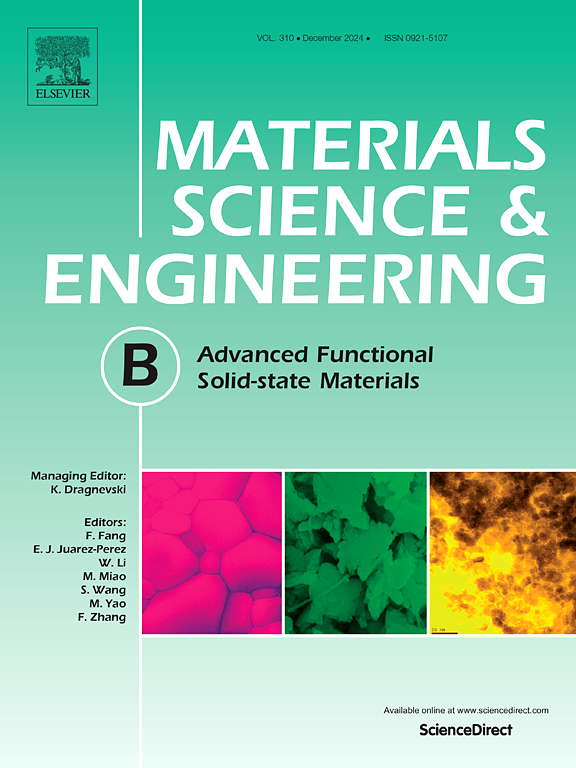使用磺酸功能化分层多孔磷酸锆进行高选择性铀分离:模拟和机理研究
IF 3.9
3区 材料科学
Q2 MATERIALS SCIENCE, MULTIDISCIPLINARY
引用次数: 0
摘要
日益严峻的核污染挑战要求开发高效、高选择性的先进吸附材料。本研究通过简单的自组装策略合成了一种分层多孔磷酸锆吸附剂(H-ZrP),并开发了其磺酸功能化衍生物(H-ZrP- so3h),用于选择性去除U(VI)。综合表征表明,H-ZrP具有独特的分层孔隙结构、高比表面积和优异的热稳定性。批量实验表明,两种材料均表现出优异的U(VI)吸附能力:H-ZrP为372.4 mg g−1,H-ZrP- so3h为290.5 mg g−1。动力学和等温线分析证实了化学吸附为主的单层吸附,用伪二阶(R2 >;0.99)和Langmuir模型(R2 >;0.98)。H-ZrP-SO3H在V/U体系中获得了更高的选择性,尽管由于优化的表面电荷相互作用降低了孔隙度。H-ZrP和H-ZrP- so3h表现出出色的可重用性、保持性和稳定性。经过5次吸附-解吸循环,脱除效率达99%,并保持结构完整性。表面络合模拟表明,吸附过程受静电吸引和氧基表面络合的多阶段吸附机制支配。总之,这项工作提出了高效功能化磷酸盐基吸附剂来调节界面电荷动力学,以增强U(VI)的吸附。本文章由计算机程序翻译,如有差异,请以英文原文为准。

Highly selective uranium separation using sulfonic acid‑functionalized hierarchically porous zirconium phosphate: Modelling and mechanism study
The growing challenges of nuclear pollution necessitate the development of advanced sorption materials with high efficiency and improved selectivity. In this work, a hierarchical porous zirconium phosphate sorbent (H-ZrP) was synthesized via a facile self-assembly strategy, and its sulfonic acid-functionalized derivative (H-ZrP-SO3H) was developed for selective U(VI) removal. Comprehensive characterization demonstrates that H-ZrP possesses a unique hierarchical pore architecture, high specific surface area, and excellent thermal stability. Batch experiments reveal that both materials exhibit exceptional U(VI) sorption capacities: 372.4 mg g−1 for H-ZrP and 290.5 mg g−1 for H-ZrP-SO3H. Kinetic and isotherm analyses confirm chemisorption-dominated monolayer sorption, well-described by pseudo-second-order (R2 > 0.99) and Langmuir models (R2 > 0.98). H-ZrP-SO3H achieves higher selectivity in V/U systems despite reduced porosity due to optimized surface charge interactions. H-ZrP and H-ZrP-SO3H demonstrate outstanding reusability, retaining > 99 % removal efficiency after five sorption–desorption cycles with preserved structural integrity. Surface complexation modelling reveals that the sorption process is dominated by a multi-stage sorption mechanism: electrostatic attraction and surface complexation via oxygenated groups. In summary, this work presents highly efficient functionalized phosphate-based sorbents to regulate interfacial charge dynamics for enhanced U(VI) sorption.
求助全文
通过发布文献求助,成功后即可免费获取论文全文。
去求助
来源期刊

Materials Science and Engineering: B
工程技术-材料科学:综合
CiteScore
5.60
自引率
2.80%
发文量
481
审稿时长
3.5 months
期刊介绍:
The journal provides an international medium for the publication of theoretical and experimental studies and reviews related to the electronic, electrochemical, ionic, magnetic, optical, and biosensing properties of solid state materials in bulk, thin film and particulate forms. Papers dealing with synthesis, processing, characterization, structure, physical properties and computational aspects of nano-crystalline, crystalline, amorphous and glassy forms of ceramics, semiconductors, layered insertion compounds, low-dimensional compounds and systems, fast-ion conductors, polymers and dielectrics are viewed as suitable for publication. Articles focused on nano-structured aspects of these advanced solid-state materials will also be considered suitable.
 求助内容:
求助内容: 应助结果提醒方式:
应助结果提醒方式:


